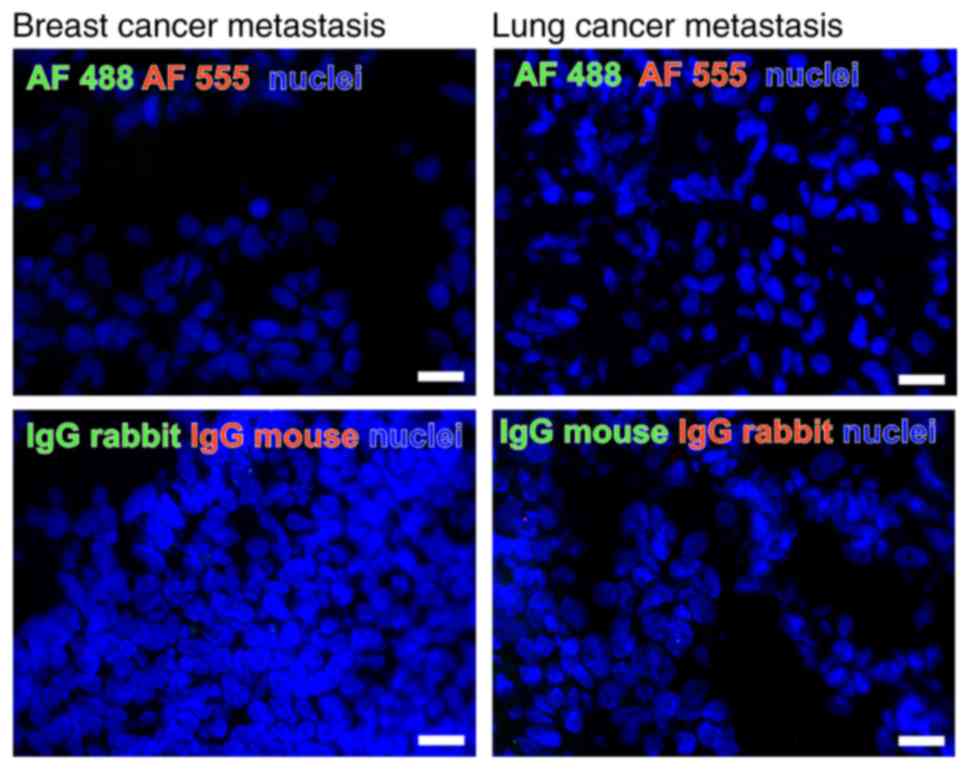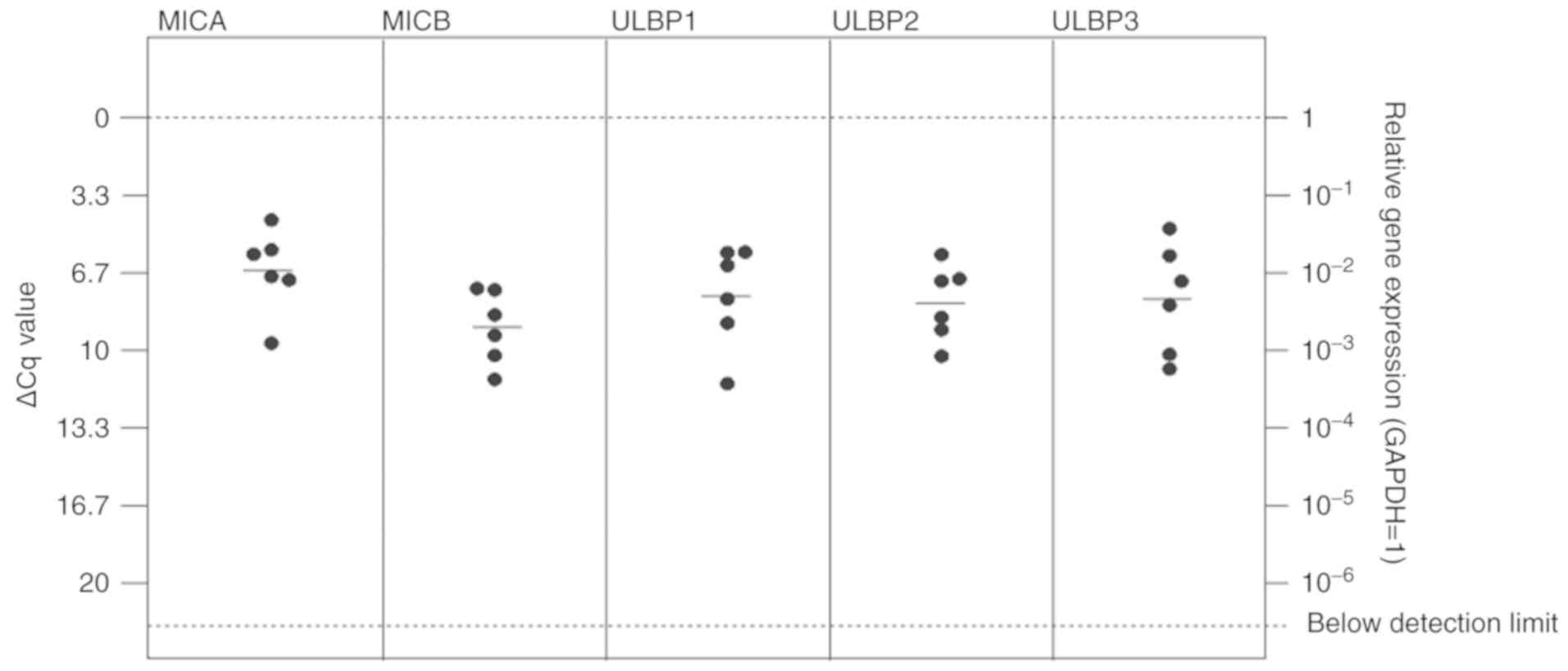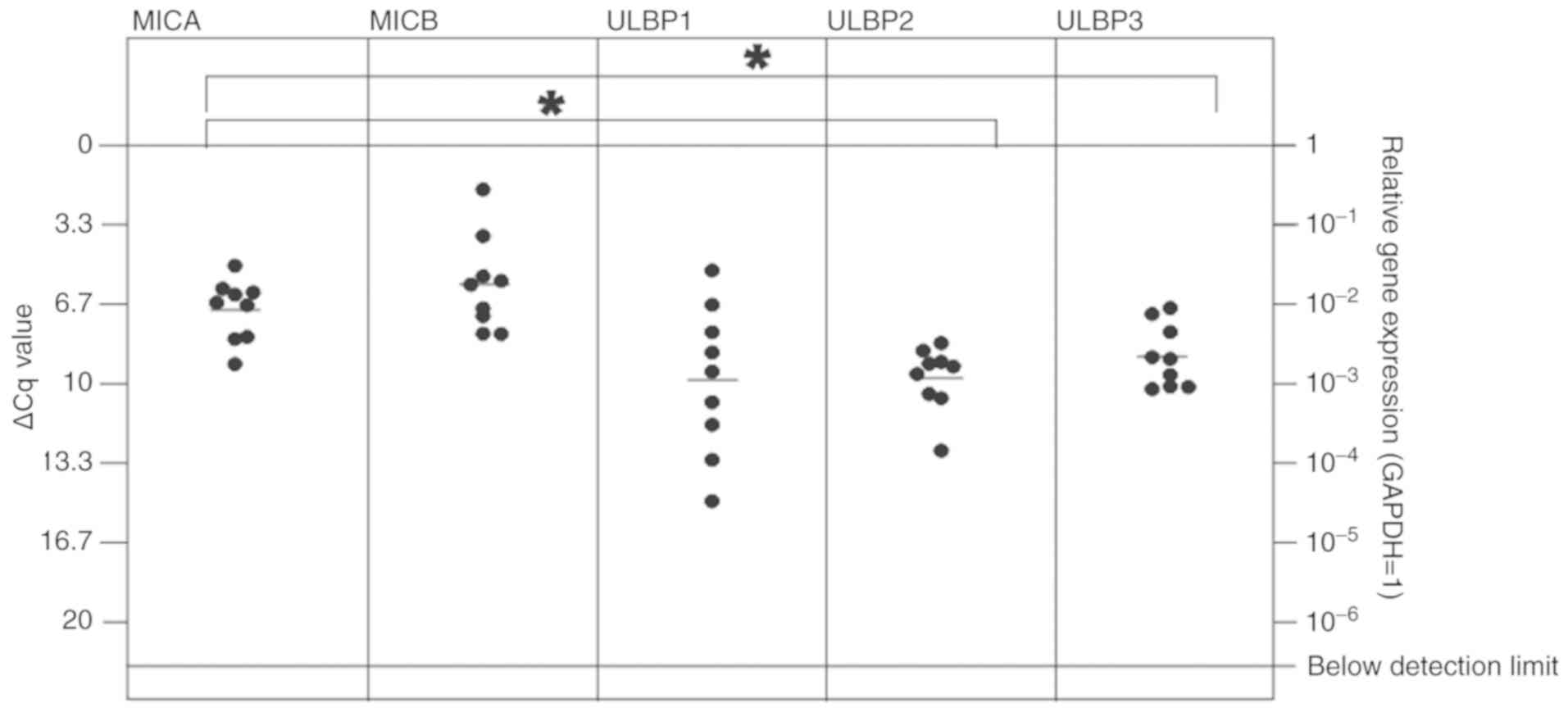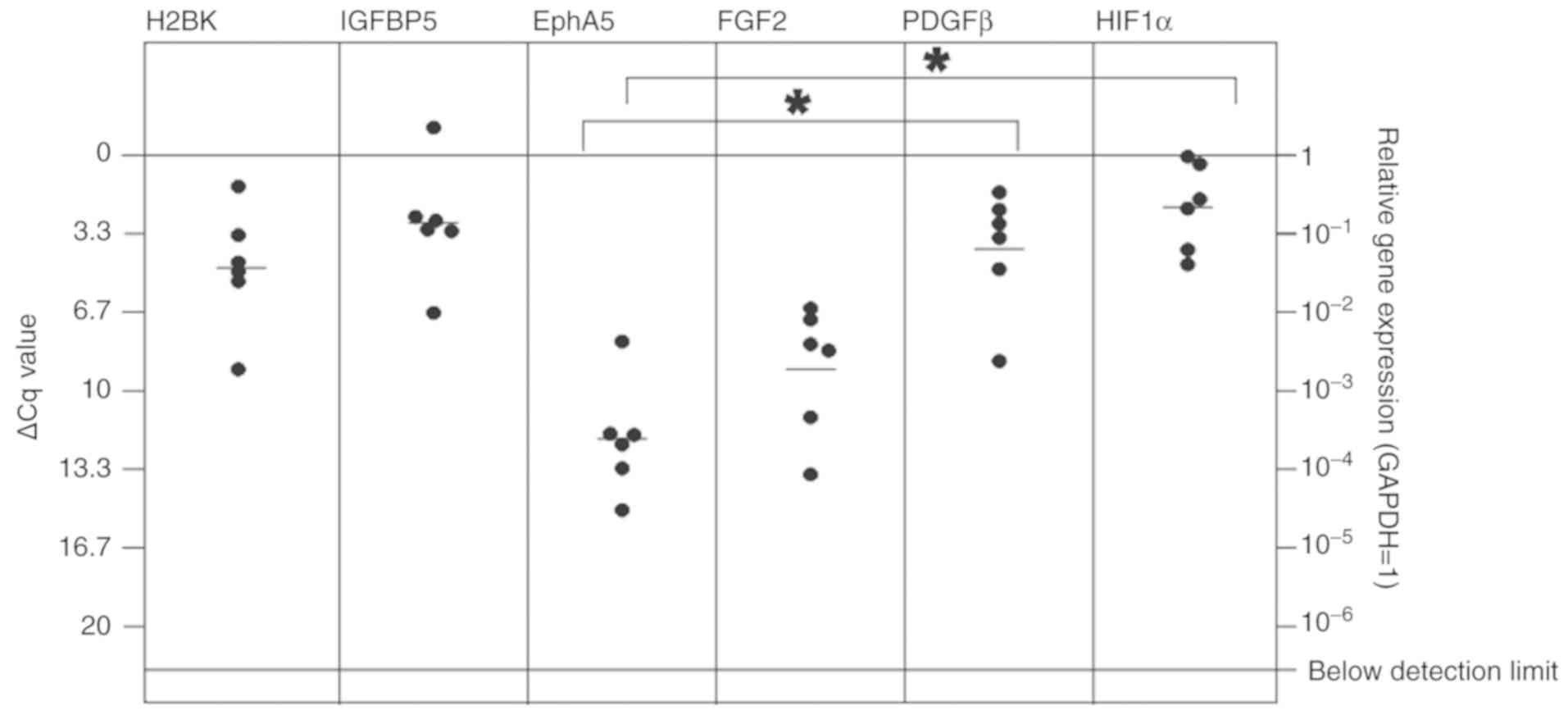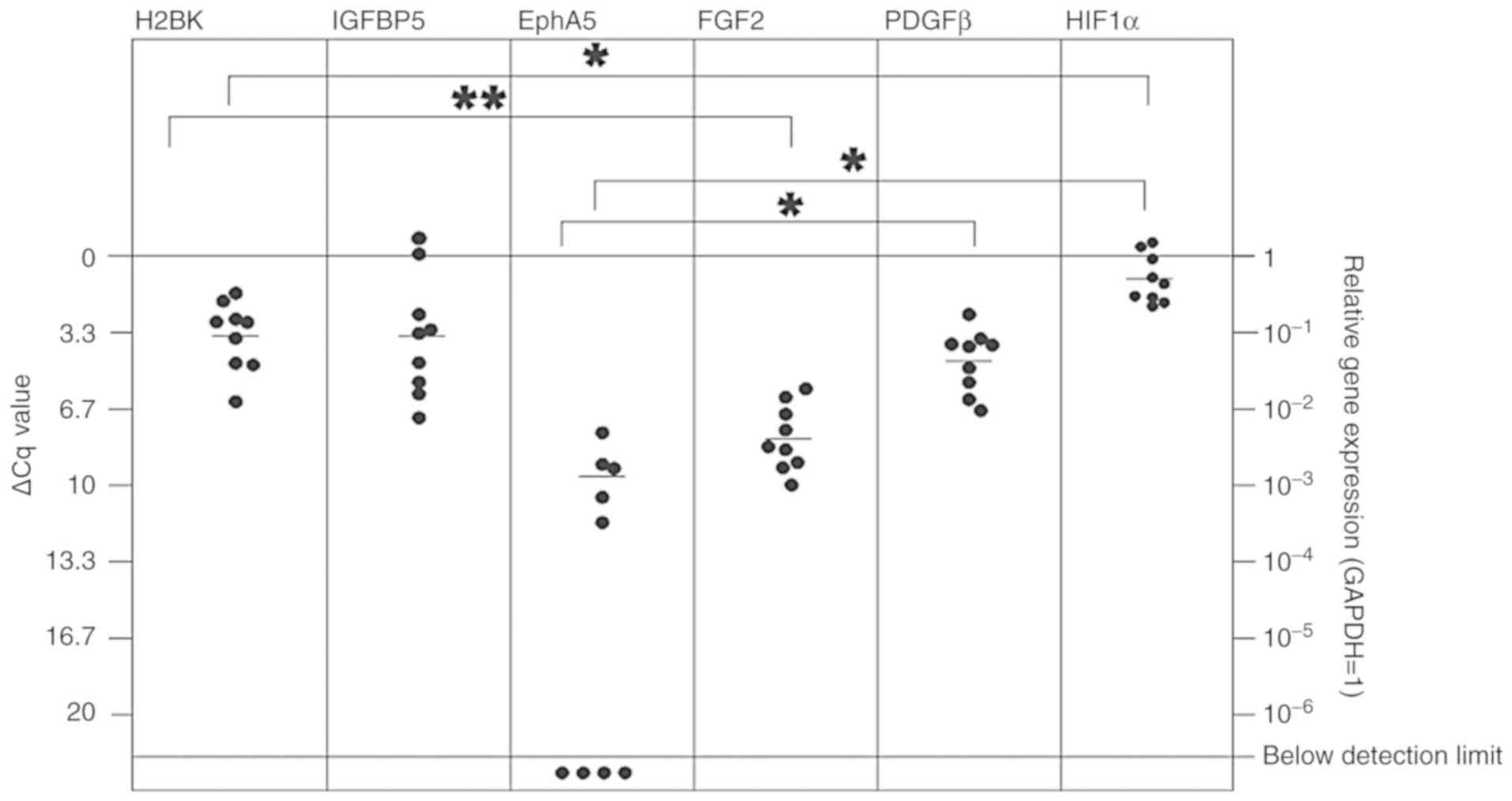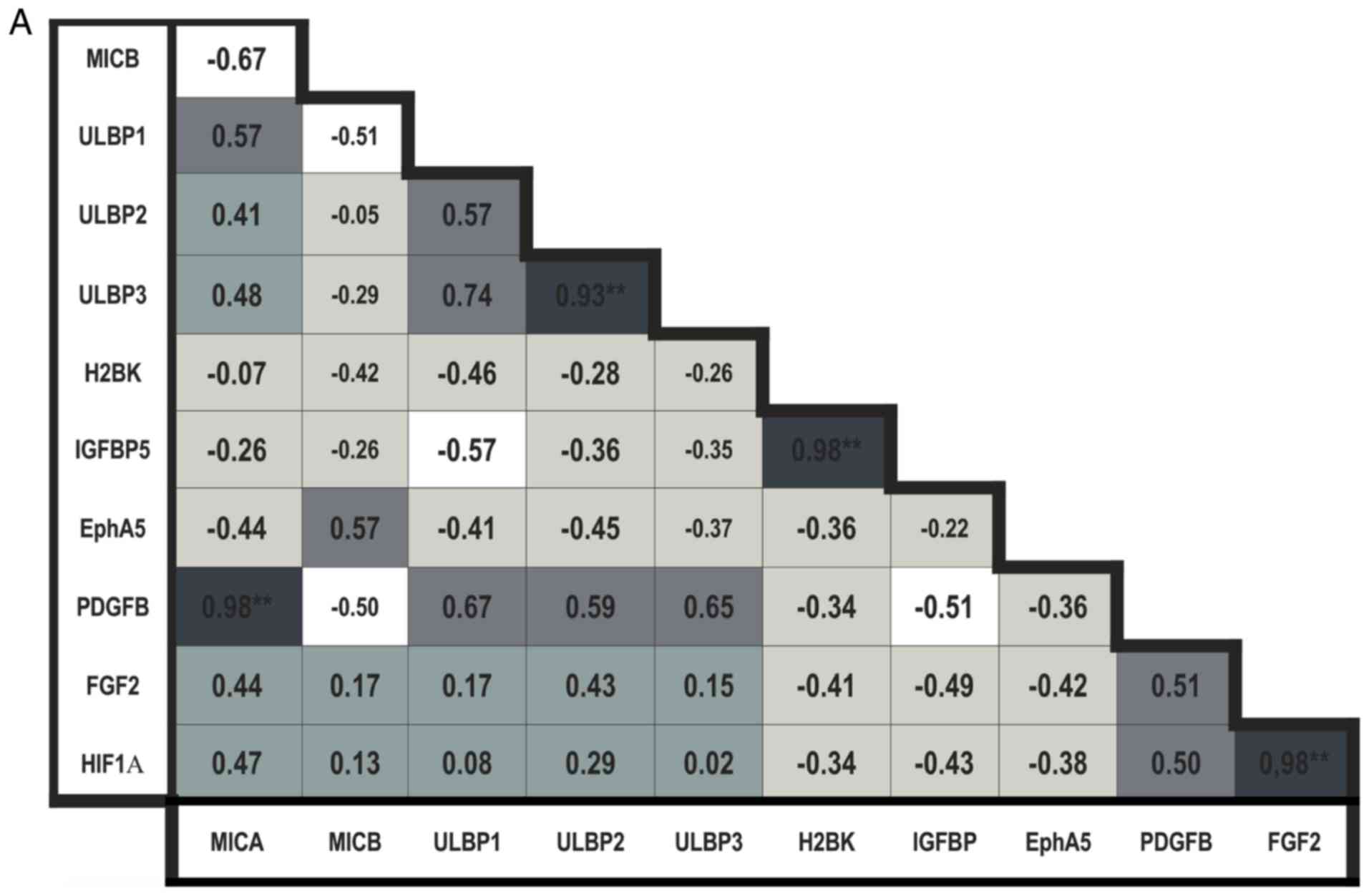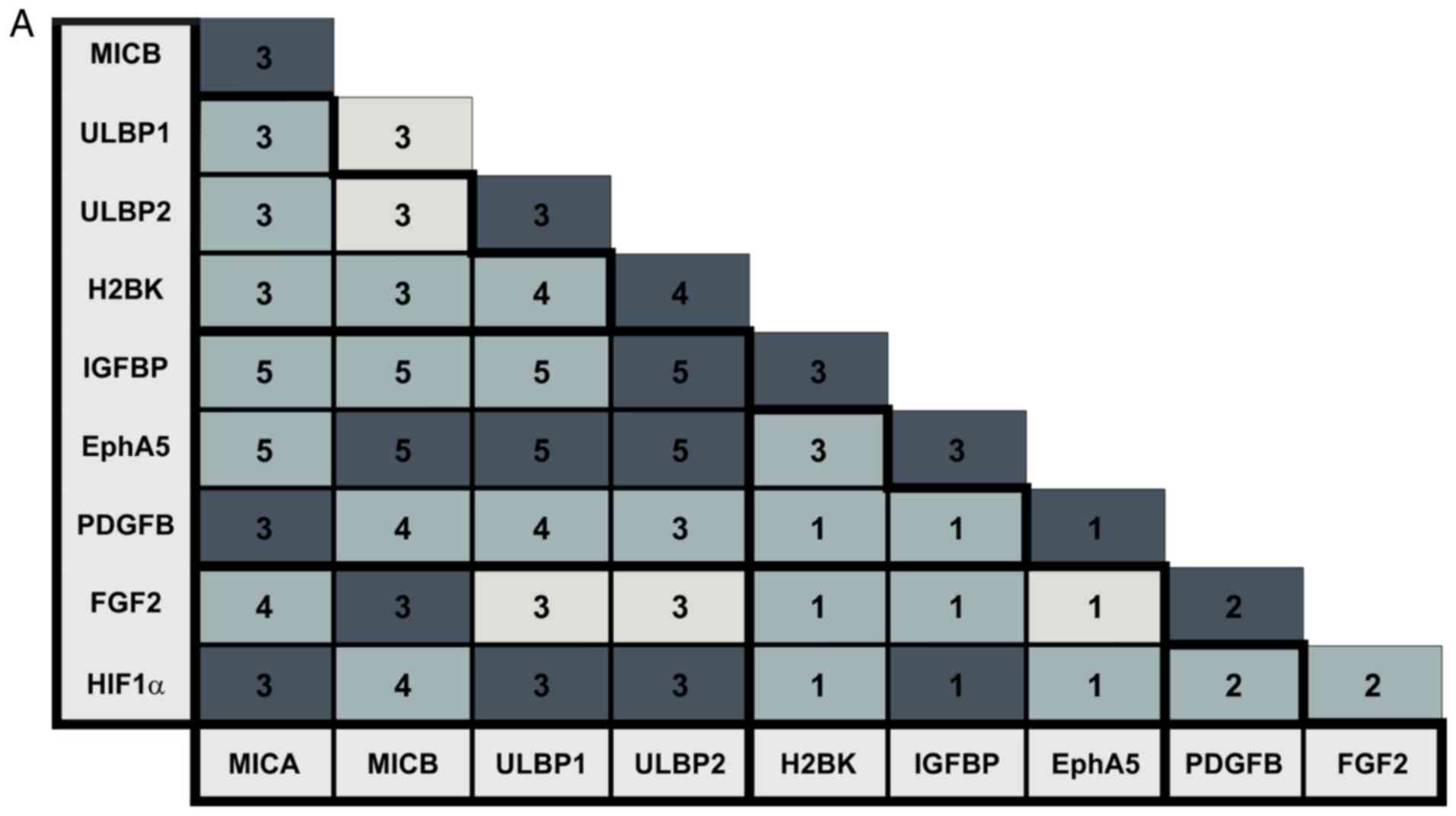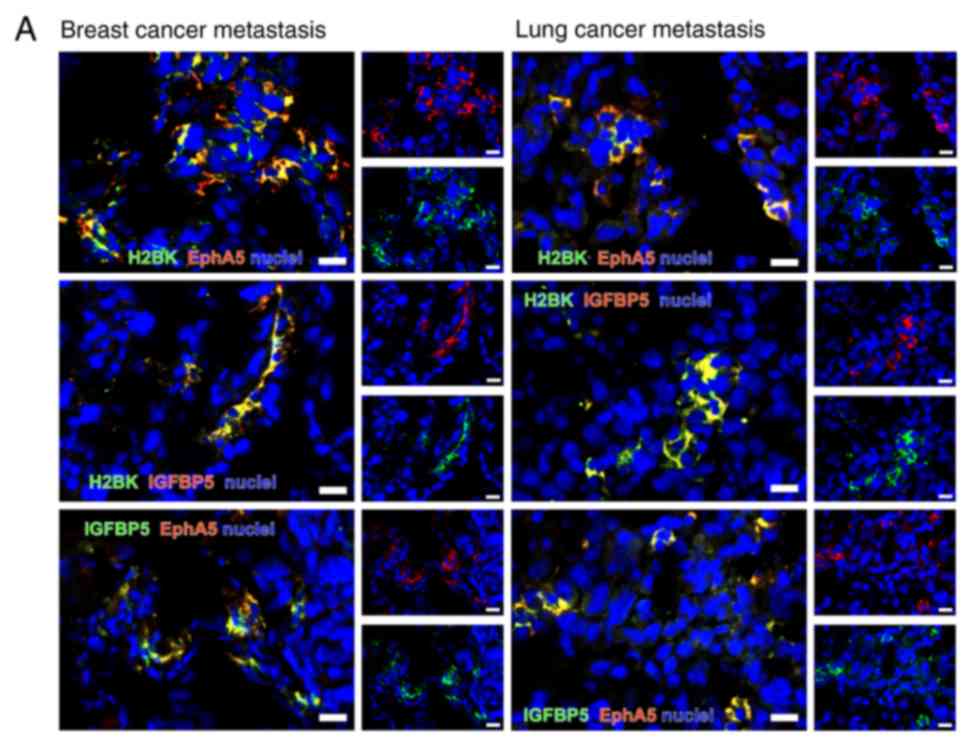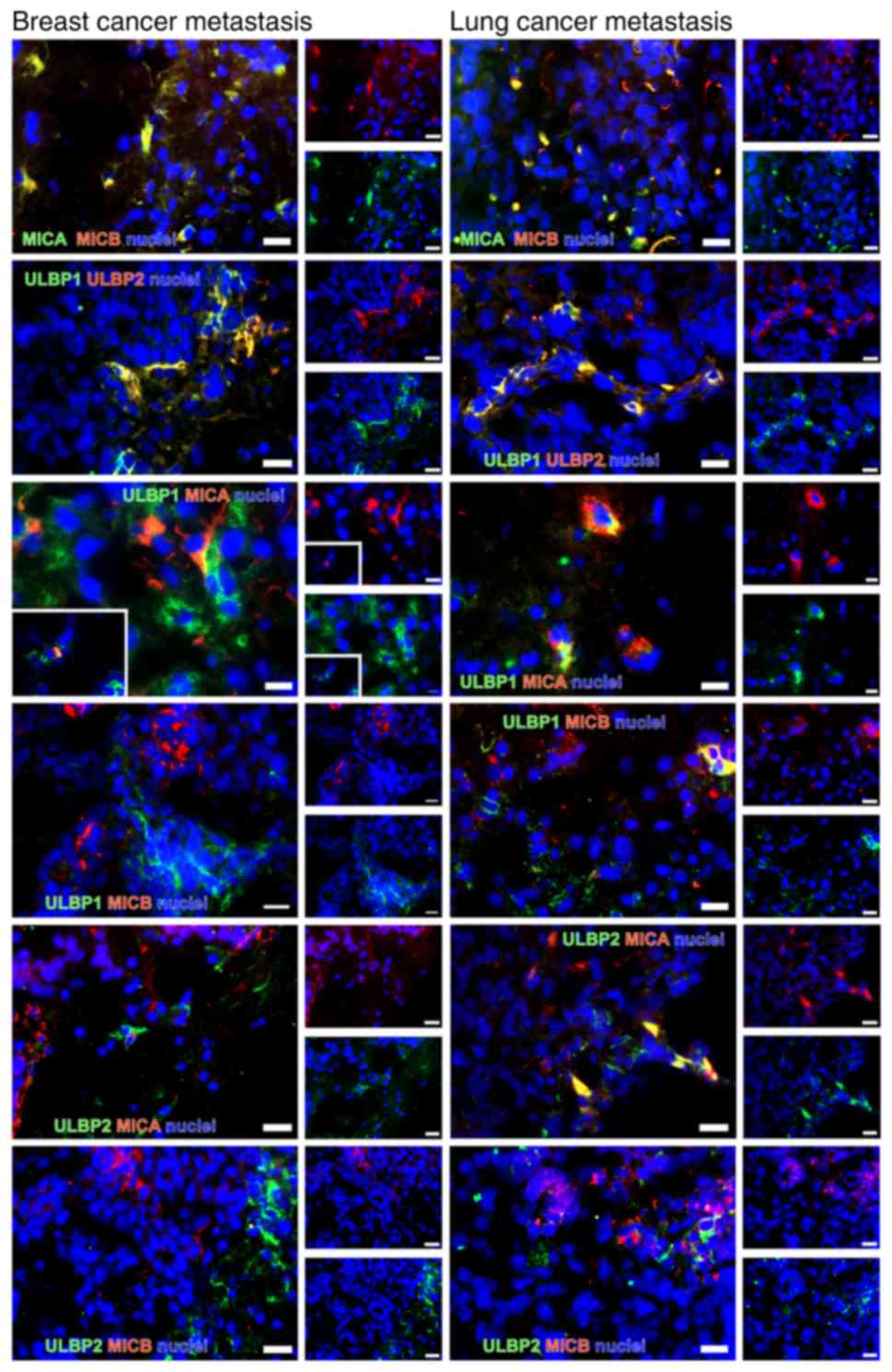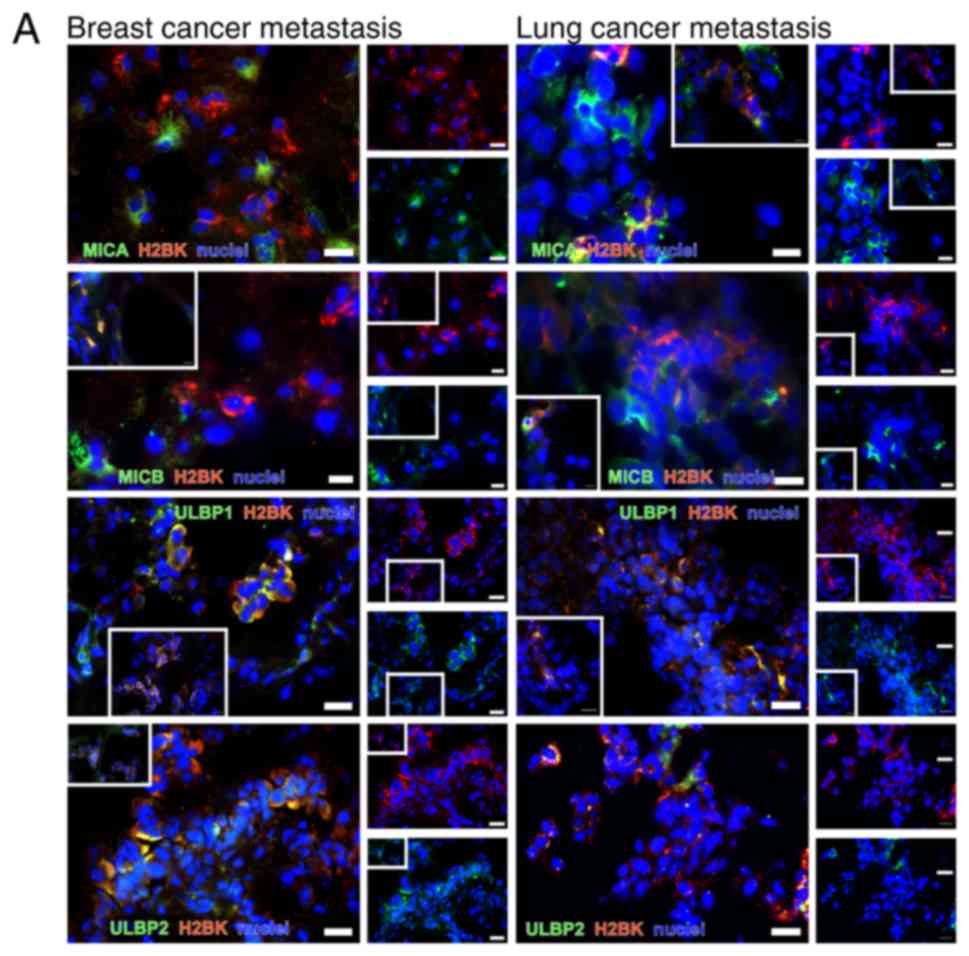|
1
|
Doron H, Pukrop T and Erez N: A Blazing
Landscape: Neuroinflammation shapes brain metastasis. Cancer Res.
79:423–436. 2019. View Article : Google Scholar : PubMed/NCBI
|
|
2
|
Cagney DN, Martin AM, Catalano PJ, Redig
AJ, Lin NU, Lee EQ, Wen PY, Dunn IF, Bi WL, Weiss SE, et al:
Incidence and prognosis of patients with brain metastases at
diagnosis of systemic malignancy: A population-based study. Neuro
Oncol. 19:1511–1521. 2017. View Article : Google Scholar : PubMed/NCBI
|
|
3
|
Berghoff AS, Schur S, Füreder LM,
Gatterbauer B, Dieckmann K, Widhalm G, Hainfellner J, Zielinski CC,
Birner P, Bartsch R and Preusser M: Descriptive statistical
analysis of a real life cohort of 2419 patients with brain
metastases of solid cancers. ESMO Open. 1:e0000242016. View Article : Google Scholar : PubMed/NCBI
|
|
4
|
Ekici K, Temelli O, Dikilitas M, Halil
Dursun I, Bozdag Kaplan N and Kekilli E: Survival and prognostic
factors in patients with brain metastasis: Single center
experience. J BUON. 21:958–963. 2016.PubMed/NCBI
|
|
5
|
Takei H, Rouah E and Ishida Y: Brain
metastasis: Clinical characteristics, pathological findings and
molecular subtyping for therapeutic implications. Brain Tumor
Pathol. 33:1–12. 2016. View Article : Google Scholar
|
|
6
|
Luzzi KJ, MacDonald IC, Schmidt EE,
Kerkvliet N, Morris VL, Chambers AF and Groom AC: Multistep nature
of metastatic inefficiency: Dormancy of solitary cells after
successful extrava-sation and limited survival of early
micrometastases. Am J Pathol. 153:865–873. 1998. View Article : Google Scholar : PubMed/NCBI
|
|
7
|
Gužvić M and Klein CA: Cancer dormancy:
Time to explore its clinical relevance. Breast Cancer Res.
15:3212013. View
Article : Google Scholar
|
|
8
|
Naumov GN, Bender E, Zurakowski D, Kang
SY, Sampson D, Flynn E, Watnick RS, Straume O, Akslen LA, Folkman J
and Almog N: A model of human tumor dormancy: An angiogenic switch
from the nonangiogenic phenotype. J Natl Cancer Inst. 98:316–325.
2006. View Article : Google Scholar : PubMed/NCBI
|
|
9
|
Townson JL and Chambers AF: Dormancy of
solitary metastatic cells. Cell Cycle. 5:1744–1750. 2006.
View Article : Google Scholar : PubMed/NCBI
|
|
10
|
Chambers AF, Groom AC and MacDonald IC:
Dissemination and growth of cancer cells in metastatic sites. Nat
Rev Cancer. 2:563–572. 2002. View
Article : Google Scholar : PubMed/NCBI
|
|
11
|
Barkan D, El Touny LH, Michalowski AM,
Smith JA, Chu I, Davis AS, Webster JD, Hoover S, Simpson RM,
Gauldie J and Green JE: Metastatic growth from dormant cells
induced by a col-I-enriched fibrotic environment. Cancer Res.
70:5706–5716. 2010. View Article : Google Scholar : PubMed/NCBI
|
|
12
|
Wikman H, Vessella R and Pantel K: Cancer
micrometastasis and tumour dormancy. APMIS. 116:754–770. 2008.
View Article : Google Scholar : PubMed/NCBI
|
|
13
|
Holmgren L, O'Reilly MS and Folkman J:
Dormancy of micro-metastases: Balanced proliferation and apoptosis
in the presence of angiogenesis suppression. Nat Med. 1:149–153.
1995. View Article : Google Scholar : PubMed/NCBI
|
|
14
|
Achilles EG, Fernandez A, Allred EN,
Kisker O, Udagawa T, Beecken WD, Flynn E and Folkman J:
Heterogeneity of angiogenic activity in a human liposarcoma: A
proposed mechanism for 'no take' of human tumors in mice. J Natl
Cancer Inst. 93:1075–1081. 2001. View Article : Google Scholar : PubMed/NCBI
|
|
15
|
Udagawa T, Fernandez A, Achilles EG,
Folkman J and D'Amato RJ: Persistence of microscopic human cancers
in mice: Alterations in the angiogenic balance accompanies loss of
tumor dormancy. FASEB J. 16:1361–1370. 2002. View Article : Google Scholar : PubMed/NCBI
|
|
16
|
Bissell MJ and Hines WC: Why don't we get
more cancer? A proposed role of the microenvironment in restraining
cancer progression. Nat Med. 17:320–329. 2011. View Article : Google Scholar : PubMed/NCBI
|
|
17
|
Gimbrone MA Jr, Leapman SB, Cotran RS and
Folkman J: Tumor dormancy in vivo by prevention of
neovascularization. J Exp Med. 136:261–276. 1972. View Article : Google Scholar : PubMed/NCBI
|
|
18
|
Folkman J, Watson K, Ingber D and Hanahan
D: Induction of angiogenesis during the transition from hyperplasia
to neoplasia. Nature. 339:58–61. 1989. View Article : Google Scholar : PubMed/NCBI
|
|
19
|
Almog N, Ma L, Raychowdhury R, Schwager C,
Erber R, Short S, Hlatky L, Vajkoczy P, Huber PE, Folkman J and
Abdollahi A: Transcriptional switch of dormant tumors to
fast-growing angiogenic phenotype. Cancer Res. 69:836–844. 2009.
View Article : Google Scholar : PubMed/NCBI
|
|
20
|
Quesnel B: Dormant tumor cells as a
therapeutic target? Cancer Lett. 267:10–17. 2008. View Article : Google Scholar : PubMed/NCBI
|
|
21
|
Moserle L, Amadori A and Indraccolo S: The
angiogenic switch: Implications in the regulation of tumor
dormancy. Curr Mol Med. 9:935–941. 2009. View Article : Google Scholar : PubMed/NCBI
|
|
22
|
Koebel CM, Vermi W, Swann JB, Zerafa N,
Rodig SJ, Old LJ, Smyth MJ and Schreiber RD: Adaptive immunity
maintains occult cancer in an equilibrium state. Nature.
450:903–907. 2007. View Article : Google Scholar : PubMed/NCBI
|
|
23
|
Kenny PA and Bissell MJ: Tumor reversion:
Correction of malignant behavior by microenvironmental cues. Int J
Cancer. 107:688–695. 2003. View Article : Google Scholar : PubMed/NCBI
|
|
24
|
Barkan D, Green JE and Chambers AF:
Extracellular matrix: A gatekeeper in the transition from dormancy
to metastatic growth. Eur J Cancer. 46:1181–1188. 2010. View Article : Google Scholar : PubMed/NCBI
|
|
25
|
Gomis RR and Gawrzak S: Tumor cell
dormancy. Mol Oncol. 11:62–78. 2017. View Article : Google Scholar :
|
|
26
|
Walker ND, Patel J, Munoz JL, Hu M, Guiro
K, Sinha G and Rameshwar P: The bone marrow niche in support of
breast cancer dormancy. Cancer Lett. 380:263–271. 2016. View Article : Google Scholar
|
|
27
|
Tivari S, Korah R, Lindy M and Wieder R:
An in vitro dormancy model of estrogen-sensitive breast cancer in
the bone marrow: A tool for molecular mechanism studies and
hypothesis generation. J Vis Exp. e526722015.PubMed/NCBI
|
|
28
|
Patel P and Chen EI: Cancer stem cells,
tumor dormancy, and metastasis. Front Endocrinol (Lausanne).
3:1252012. View Article : Google Scholar
|
|
29
|
de Jong JS, van Diest PJ, van der Valk P
and Baak JP: Expression of growth factors, growth factor receptors
and apoptosis related proteins in invasive breast cancer: Relation
to apoptotic rate. Breast Cancer Res Treat. 66:201–208. 2001.
View Article : Google Scholar : PubMed/NCBI
|
|
30
|
Cervi D, Yip TT, Bhattacharya N, Podust
VN, Peterson J, Abou-Slaybi A, Naumov GN, Bender E, Almog N,
Italiano JE Jr, et al: Platelet-associated PF-4 as a biomarker of
early tumor growth. Blood. 111:1201–1207. 2008. View Article : Google Scholar
|
|
31
|
Fluegen G, Avivar-Valderas A, Wang Y,
Padgen MR, Williams JK, Nobre AR, Calvo V, Cheung JF, Bravo-Cordero
JJ, Entenberg D, et al: Phenotypic heterogeneity of disseminated
tumour cells is preset by primary tumour hypoxic microenvironments.
Nat Cell Biol. 19:120–132. 2017. View Article : Google Scholar : PubMed/NCBI
|
|
32
|
Endo H, Okami J, Okuyama H, Nishizawa Y,
Imamura F and Inoue M: The induction of MIG6 under hypoxic
conditions is critical for dormancy in primary cultured lung cancer
cells with activating EGFR mutations. Oncogene. 36:2824–2834. 2017.
View Article : Google Scholar
|
|
33
|
Jiang ZF, Wang M, Xu JL and Ning YJ:
Hypoxia promotes mitochondrial glutamine metabolism through
HIF1α-GDH pathway in human lung cancer cells. Biochem Biophys Res
Commun. 483:32–38. 2017. View Article : Google Scholar : PubMed/NCBI
|
|
34
|
Abdollahi A, Hahnfeldt P, Maercker C,
Gröne HJ, Debus J, Ansorge W, Folkman J, Hlatky L and Huber PE:
Endostatin's antiangiogenic signaling network. Mol Cell.
13:649–663. 2004. View Article : Google Scholar : PubMed/NCBI
|
|
35
|
Yancopoulos GD, Klagsbrun M and Folkman J:
Vasculogenesis, angiogenesis, and growth factors: Ephrins enter the
fray at the border. Cell. 93:661–664. 1998. View Article : Google Scholar : PubMed/NCBI
|
|
36
|
Foulstone E, Prince S, Zaccheo O, Burns
JL, Harper J, Jacobs C, Church D and Hassan AB: Insulin-like growth
factor ligands, receptors, and binding proteins in cancer. J
Pathol. 205:145–153. 2005. View Article : Google Scholar : PubMed/NCBI
|
|
37
|
Lassalle P, Molet S, Janin A, Heyden JV,
Tavernier J, Fiers W, Devos R and Tonnel AB: ESM-1 is a novel human
endothelial cell-specific molecule expressed in lung and regulated
by cytokines. J Biol Chem. 271:20458–20464. 1996. View Article : Google Scholar : PubMed/NCBI
|
|
38
|
Adamski V, Hempelmann A, Flüh C, Lucius R,
Synowitz M, Hattermann K and Held-Feindt J: Dormant glioblastoma
cells acquire stem cell characteristics and are differentially
affected by Temozolomide and AT101 treatment. Oncotarget.
8:108064–108078. 2017. View Article : Google Scholar
|
|
39
|
Jung TY, Choi YD, Kim YH, Lee JJ, Kim HS,
Kim JS, Kim SK, Jung S and Cho D: Immunological characterization of
glioblastoma cells for immunotherapy. Anticancer Res. 33:2525–2533.
2013.PubMed/NCBI
|
|
40
|
Chitadze G, Flüh C, Quabius ES,
Freitag-Wolf S, Peters C, Lettau M, Bhat J, Wesch D, Oberg HH,
Luecke S, et al: In-depth immunophenotyping of patients with
glioblastoma multiforme: Impact of steroid treatment.
Oncoimmunology. 6:e13588392017. View Article : Google Scholar : PubMed/NCBI
|
|
41
|
Nausch N and Cerwenka A: NKG2D ligands in
tumor immunity. Oncogene. 27:5944–5958. 2008. View Article : Google Scholar : PubMed/NCBI
|
|
42
|
Raulet DH, Gasser S, Gowen BG, Deng W and
Jung H: Regulation of ligands for the NKG2D activating receptor.
Annu Rev Immunol. 31:413–441. 2013. View Article : Google Scholar : PubMed/NCBI
|
|
43
|
Chitadze G, Lettau M, Luecke S, Wang T,
Janssen O, Fürst D, Mytilineos J, Wesch D, Oberg HH, Held-Feindt J
and Kabelitz D: NKG2D- and T-cell receptor-dependent lysis of
malignant glioma cell lines by human γδ T cells: Modulation by
temozolomide and A disintegrin and metalloproteases 10 and 17
inhibitors. Oncoimmunology. 5:e10932762015. View Article : Google Scholar
|
|
44
|
Chitadze G, Bhat J, Lettau M, Janssen O
and Kabelitz D: Generation of soluble NKG2D ligands: Proteolytic
cleavage, exosome secretion and functional implications. Scand J
Immunol. 78:120–129. 2013. View Article : Google Scholar : PubMed/NCBI
|
|
45
|
Flüh C, Chitadze G, Adamski V, Hattermann
K, Synowitz M, Kabelitz D and Held-Feindt J: NKG2D ligands in
glioma stem-like cells: Expression in situ and in vitro. Histochem
Cell Biol. 149:219–233. 2018. View Article : Google Scholar : PubMed/NCBI
|
|
46
|
Werner-Klein M and Klein CA: Therapy
resistance beyond cellular dormancy. Nat Cell Biol. 21:117–119.
2019. View Article : Google Scholar : PubMed/NCBI
|
|
47
|
Chomczynski P and Sacchi N: Single-step
method of RNA isolation by acid guanidinium
thiocyanate-phenol-chloroform extraction. Anal Biochem.
162:156–159. 1987. View Article : Google Scholar : PubMed/NCBI
|
|
48
|
Livak KJ and Schmittgen TD: Analysis of
relative gene expression data using real-time quantitative PCR and
the 2(-Delta Delta C(T)) method. Methods. 25:402–498. 2001.
View Article : Google Scholar
|
|
49
|
Achrol AS, Rennert RC, Anders C, Soffietti
R, Ahluwalia MS, Nayak L, Peters S, Arvold ND, Harsh GR, Steeg PS
and Chang SD: Brain metastases. Nat Rev Dis Primers. 5:52019.
View Article : Google Scholar : PubMed/NCBI
|
|
50
|
Hall WA, Djalilian HR, Nussbaum ES and Cho
KH: Long-term survival with metastatic cancer to the brain. Med
Oncol. 17:279–286. 2000. View Article : Google Scholar : PubMed/NCBI
|
|
51
|
Carlson P, Dasgupta A, Grzelak CA, Kim J,
Barrett A, Coleman IM, Shor RE, Goddard ET, Dai J, Schweitzer EM,
et al: Targeting the perivascular niche sensitizes disseminated
tumour cells to chemotherapy. Nat Cell Biol. 21:238–250. 2019.
View Article : Google Scholar : PubMed/NCBI
|
|
52
|
Shersher DD, Vercillo MS, Fhied C, Basu S,
Rouhi O, Mahon B, Coon JS, Warren WH, Faber LP, Hong E, et al:
Biomarkers of the insulin-like growth factor pathway predict
progression and outcome in lung cancer. Ann Thorac Surg.
92:1805–1811; discussion 1811. 2011. View Article : Google Scholar : PubMed/NCBI
|
|
53
|
Beattie J, Allan GJ, Lochrie JD and Flint
DJ: Insulin-like growth factor-binding protein-5 (IGFBP-5): A
critical member of the IGF axis. Biochem J. 395:1–19. 2006.
View Article : Google Scholar : PubMed/NCBI
|
|
54
|
Sureshbabu A, Okajima H, Yamanaka D,
Tonner E, Shastri S, Maycock J, Szymanowska M, Shand J, Takahashi
S, Beattie J, et al: IGFBP5 induces cell adhesion, increases cell
survival and inhibits cell migration in MCF-7 human breast cancer
cells. J Cell Sci. 125:1693–1705. 2012. View Article : Google Scholar : PubMed/NCBI
|
|
55
|
Li Y, Chu J, Feng W, Yang M, Zhang Y,
Zhang Y, Qin Y, Xu J, Li J, Vasilatos SN, et al: EPHA5 mediates
trastuzumab resistance in HER2-positive breast cancers through
regulating cancer stem cell-like properties. FASEB J. 33:4851–4865.
2019. View Article : Google Scholar : PubMed/NCBI
|
|
56
|
Staquicini FI, Qian MD, Salameh A, Dobroff
AS, Edwards JK, Cimino DF, Moeller BJ, Kelly P, Nunez MI, Tang X,
et al: Receptor tyrosine kinase EphA5 is a functional molecular
target in human lung cancer. J Biol Chem. 290:7345–7359. 2015.
View Article : Google Scholar : PubMed/NCBI
|
|
57
|
Sperduto PW, Kased N, Roberge D, Chao ST,
Shanley R, Luo X, Sneed PK, Suh J, Weil RJ, Jensen AW, et al: The
effect of tumor subtype on the time from primary diagnosis to
development of brain metastases and survival in patients with
breast cancer. J Neurooncol. 112:467–472. 2013. View Article : Google Scholar : PubMed/NCBI
|
|
58
|
Perus LJM and Walsh LA: Microenvironmental
heterogeneity in brain malignancies. Front Immunol. 10:22942019.
View Article : Google Scholar : PubMed/NCBI
|
|
59
|
Kienast Y, von Baumgarten L, Fuhrmann M,
Klinkert WE, Goldbrunner R, Herms J and Winkler F: Real-time
imaging reveals the single steps of brain metastasis formation. Nat
Med. 16:116–122. 2010. View Article : Google Scholar
|
|
60
|
Keith B, Johnson RS and Simon MC: HIF1α
and HIF2α: Sibling rivalry in hypoxic tumour growth and
progression. Nat Rev Cancer. 12:9–22. 2011. View Article : Google Scholar : PubMed/NCBI
|
|
61
|
Malladi S, Macalinao DG, Jin X, He L,
Basnet H, Zou Y, de Stanchina E and Massagué J: Metastatic latency
and immune evasion through autocrine inhibition of WNT. Cell.
165:45–60. 2016. View Article : Google Scholar : PubMed/NCBI
|
|
62
|
Chitadze G, Lettau M, Bhat J, Wesch D,
Steinle A, Fürst D, Mytilineos J, Kalthoff H, Janssen O, Oberg HH
and Kabelitz D: Shedding of endogenous MHC class I-related chain
molecules A and B from different human tumor entities:
Heterogeneous involvement of the 'a disintegrin and
metalloproteases' 10-17. Int J Cancer. 133:1557–1566. 2013.
View Article : Google Scholar : PubMed/NCBI
|
|
63
|
Malemud CJ: Inhibition of MMPs and
ADAM/ADAMTS. Biochem Pharmacol. 165:33–40. 2019. View Article : Google Scholar : PubMed/NCBI
|
|
64
|
Pende D, Rivera P, Marcenaro S, Chang CC,
Biassoni R, Conte R, Kubin M, Cosman D, Ferrone S, Moretta L and
Moretta A: Major histocompatibility complex class I-related chain A
and UL16-binding protein expression on tumor cell lines of
different histotypes: Analysis of tumor susceptibility to
NKG2D-dependent natural killer cell cytotoxicity. Cancer Res.
62:6178–6186. 2002.PubMed/NCBI
|
|
65
|
Vetter CS, Groh V, thor Straten P, Spies
T, Bröcker EB and Becker JC: Expression of stress-induced MHC class
I related chain molecules on human melanoma. J Invest Dermatol.
118:600–605. 2002. View Article : Google Scholar : PubMed/NCBI
|
|
66
|
Salih HR, Antropius H, Gieseke F, Lutz SZ,
Kanz L, Rammensee HG and Steinle A: Functional expression and
release of ligands for the activating immunoreceptor NKG2D in
leukemia. Blood. 102:1389–1396. 2003. View Article : Google Scholar : PubMed/NCBI
|
|
67
|
Watson NF, Spendlove I, Madjd Z, McGilvray
R, Green AR, Ellis IO, Scholefield JH and Durrant LG: Expression of
the stress-related MHC class I chain-related protein MICA is an
indicator of good prognosis in colorectal cancer patients. Int J
Cancer. 118:1445–1452. 2006. View Article : Google Scholar
|
|
68
|
Castriconi R, Dondero A, Negri F, Bellora
F, Nozza P, Carnemolla B, Raso A, Moretta L, Moretta A and Bottino
C: Both CD133+ and CD133- medulloblastoma cell lines express
ligands for triggering NK receptors and are susceptible to
NK-mediated cytotoxicity. Eur J Immunol. 37:3190–3196. 2007.
View Article : Google Scholar : PubMed/NCBI
|
|
69
|
Wolpert F, Tritschler I, Steinle A, Weller
M and Eisele G: A disintegrin and metalloproteinases 10 and 17
modulate the immunogenicity of glioblastoma-initiating cells. Neuro
Oncol. 16:382–391. 2014. View Article : Google Scholar :
|
|
70
|
Wu J, Chalupny NJ, Manley TJ, Riddell SR,
Cosman D and Spies T: Intracellular retention of the MHC class
I-related chain B ligand of NKG2D by the human cytomegalovirus UL16
glyco-protein. J Immunol. 170:4196–4200. 2003. View Article : Google Scholar : PubMed/NCBI
|
|
71
|
Spreu J, Stehle T and Steinle A: Human
cytomegalovirus-encoded UL16 discriminates MIC molecules by their
alpha2 domains. J Immunol. 177:3143–3149. 2006. View Article : Google Scholar : PubMed/NCBI
|
|
72
|
Zhang ZX, Wang S, Huang X, Min WP, Sun H,
Liu W, Garcia B and Jevnikar AM: NK cells induce apoptosis in
tubular epithelial cells and contribute to renal
ischemia-reperfusion injury. J Immunol. 181:7489–7498. 2008.
View Article : Google Scholar : PubMed/NCBI
|















